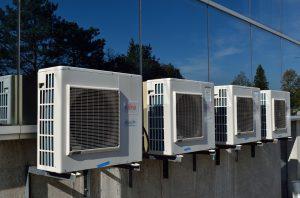Why Does My Air Conditioner Stop Blowing Cold Air?
Check Your Thermostat
First and foremost, examine your thermostat. When an air conditioning stops blowing cold air, it’s typically because the thermostat is set incorrectly or was altered. Children often play with thermostats they can reach. If this is the case, simply reset your device. If your fan is blowing, but there is no frigid air, check to see whether the thermostat has been set to “on” or “auto.” If set to “on,” the fan will remain on at all times, even when the air conditioning isn’t actually running. This setting was designed to circulate air throughout the home. Many homeowners hear the fan and immediately think their system is running. This is not the case, though. Change the thermostat over to “auto” to avoid this issue.Swap Air Filters
Your air conditioning system is a machine. Like any machine, your system requires proper care and thorough cleanings. Typically, it’s smart to clean the system monthly. For preventative maintenance, consider setting up a yearly plan with a trusted technician. On your own, you can change out the air filter regularly. In homes with pets, the air filter should be switched out once per month. For homes that do not use their system as often, every two months will suffice. Over time, your air filter will accumulate dust, debris, and particles from the air. These particles will then block the filter, reducing the unit’s overall efficiency. When this happens, you’ll notice a lack of cold air in the home. Furthermore, a dirty filter can cause your condenser unit to freeze completely. If the condenser freezes, you won’t have any chilling air. Today’s market is flooded with “high-efficiency” air filters. While some are useful, others are problematic. These filters are designed specifically to remove minuscule particles from the air. They ultimately end up restricting airflow. This will, again, cause the condenser to free.Examine Condensers
The third most common reason for an air conditioner refusing to blow cold air is because of a dirty condenser unit. The condenser unit is the outdoor portion of your air conditioning system. The condenser coils tend to build up dirty and grime, preventing the air conditioner from cooling properly. These coils require annual cleaning to ensure peak performance. If you’re unclear on how to properly clean these coils, rely on a professional. Cleaning prevents further wear and tear. Furthermore, weeds and bushes that are too close to the outside unit can suffocate and smother the condenser. The bushes will block airflow, keeping the air conditioning system from working properly. We recommend that you cut back any bushes, trees, or gardens at least two feet around the outside unit on each side.How to Clean a Condenser
If you feel confident, you can clean the condenser on your own. We must warn you, however, that it’s safer and easier to allow an experienced professional to handle the job. If something goes wrong, you’ll have to deal with the cost of repairs in full, plus any damage you incurred. If you want to clean the condenser on your own, follow these steps:- Shut down power to the unit. Attached to the condenser, you’ll notice a metal box with a disconnect switch. Turn off the 240 volts that power the condenser.
- Wait a few moments to ensure power is completely off. Then, unscrew and remove the top panel or grille. Be careful, as the fan is attached to the top panel.
- Using a soft brush, clean the fins and coils, removing any accumulated debris or dust. Remove loose debris from the bottom portion of the unit, taking care not to bend any of the fins.
- Cover the wiring using a plastic bag. Once you’ve done this, vacuum away any remaining dirt or dust from the system.
- If you notice a bent fan, you’ll need it repaired or replaced promptly. Call a professional for this task.
- Finally, power the thermostat off, then reconnect power to the entire unit. After a few minutes, check to see if the two pipes connecting the outdoor unit and indoor unit are cold and warm, respectively.
Replace Broken Parts
Whether through heavy use or manufacturer’s errors, internal parts may become worn down or may break altogether. These parts, of course, must be replaced; otherwise, the entire system will cease to function. The parts in an air conditioning system that most commonly break are the fan and fan motor. In a properly working system, the fan will draw air from the evaporator coils, then recirculate it back into each room in the house. If the circulating fan does not work or is running too slowly, you’ll experience little to no air whatsoever. The evaporator coils will then become too cold or frost over, restricting airflow even further. The fan and the motor are both located inside the cabinet, which should be inspected by a technician annually. Be sure the fan motor turns on easily, and all the blades are intact. If the engine seizes or any fan blade is damaged, you’ll need to replace the broken part. Testing the system is a complicated endeavor, however. It’s best if you leave the task to a qualified professional.

